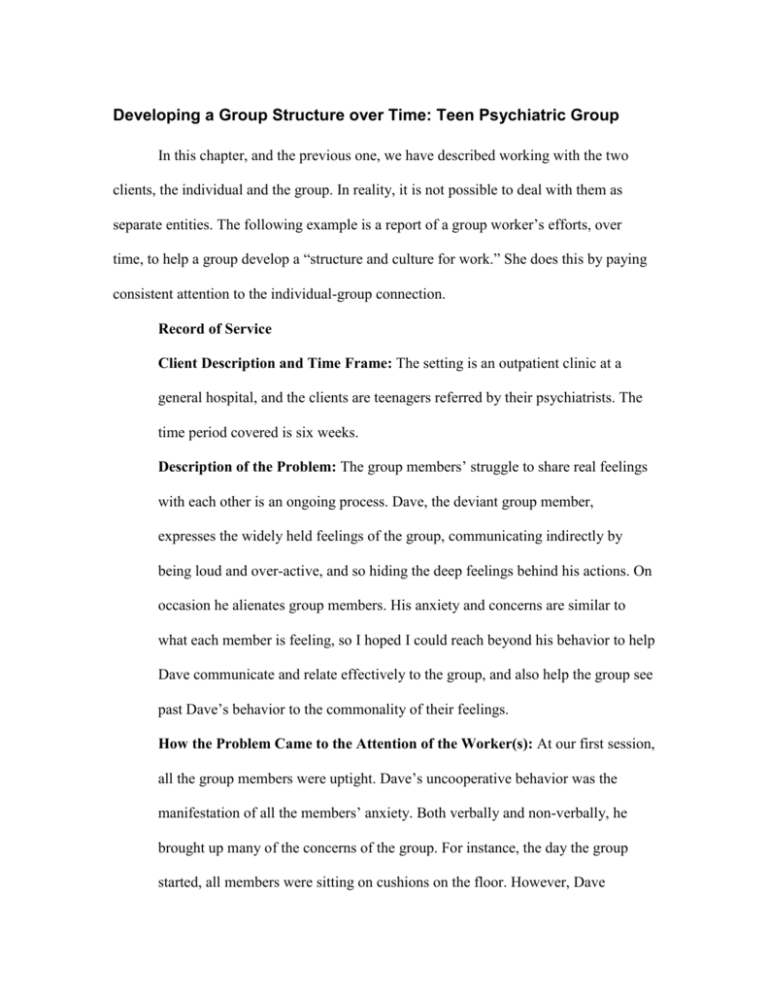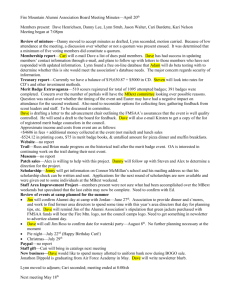Developing a Group Structure over Time: Teen Psychiatric Group
advertisement

Developing a Group Structure over Time: Teen Psychiatric Group In this chapter, and the previous one, we have described working with the two clients, the individual and the group. In reality, it is not possible to deal with them as separate entities. The following example is a report of a group worker’s efforts, over time, to help a group develop a “structure and culture for work.” She does this by paying consistent attention to the individual-group connection. Record of Service Client Description and Time Frame: The setting is an outpatient clinic at a general hospital, and the clients are teenagers referred by their psychiatrists. The time period covered is six weeks. Description of the Problem: The group members’ struggle to share real feelings with each other is an ongoing process. Dave, the deviant group member, expresses the widely held feelings of the group, communicating indirectly by being loud and over-active, and so hiding the deep feelings behind his actions. On occasion he alienates group members. His anxiety and concerns are similar to what each member is feeling, so I hoped I could reach beyond his behavior to help Dave communicate and relate effectively to the group, and also help the group see past Dave’s behavior to the commonality of their feelings. How the Problem Came to the Attention of the Worker(s): At our first session, all the group members were uptight. Dave’s uncooperative behavior was the manifestation of all the members’ anxiety. Both verbally and non-verbally, he brought up many of the concerns of the group. For instance, the day the group started, all members were sitting on cushions on the floor. However, Dave perched on a table and refused to sit on the floor. “I’m here just to listen — I won’t be doing any talking. My psychiatrist made me come to this group.” Thus, Dave started to articulate concerns felt by all members: The concern of being involved with a psychiatrist — am I nuts? Is this a group for crazies? I’m not going to share my feelings with anyone here, it’s too risky. Am I going to be accepted by other group members? I am here involuntarily. I felt that if I could reach beyond the deviant behavior to bring out the common feelings of all the group members, Dave could become an important ally to me in the group. Summary of the Work: (First Session) I tune in to the group’s feelings and unasked questions. The first week of the group, when Dave made his comment, “I’m just here to listen — I won’t be doing any talking. My psychiatrist made me come to this group,” I was in a dilemma as to which lead to take, he had given me so many. I turned to him, saying, “Yeah, it is tough, isn’t it, when you come into a group like this and you don’t know anyone.” There was a slight pause. Dave said, “Yeah.” I tried again and said, “I guess all of you were wondering and maybe feeling anxious about what the kids were going to be like in the group.” (Expressing commonality of feelings.) Connie jumped in and said, “You know I figured you had to be whacko to be in this group.” Wanda agreed, “I really thought this was a group for crazy kids, you know, but when I walked in — you all looked — well, normal.” I said that it’s hard to come to any group, but especially at a psychiatry clinic, and I could understand them being concerned. Several other members agreed, and Brian said it was easier now that he had met the others. (Second Session) I help the group deal with the authority theme. The concern with the authority theme was especially apparent in our first few weeks. Dave, as usual, had a greater sense of urgency and neatly brought it to the fore. He marched into the group session the second week and said, “Anyone mind if I lead the group today?” No objections. “Good, we won’t allow psychiatrists in.” I asked Dave what he meant. “My psychiatrist is about to drive me crazy, I just saw her for an hour.” I asked what it was about his psychiatrist that made him feel that way. “Well, she lays trips on me.” I asked if other people felt the same way. They all nodded. “I can’t talk to my social worker,” said Connie. “I can’t talk to people who haven’t done drugs or gotten drunk,” said Gayle. “They don’t treat us like we know that we’re doing,” said Chris. I said, “Are you afraid Tom (co-therapist) and I won’t treat you as if you know what you’re doing?” Silence. I added that it was important that they all understood that this was their group, and we were here to help them talk to each other, and listen, and maybe give suggestions, but not to dump on them. The group did not take me up right away on this. (Fourth Session) A few weeks later, Tom and I raised the idea of having a parents’ night (a Clinic policy), where the parents came and participated in the group. The group was immediately against this, and led by Dave, unanimously voted against our suggestion. “This is our group,” Dave said. “If we don’t want to have a parents’ night, we won’t have it.” I said I’d clear it with the head of the Clinic that we would not plan a parents’ night, as the group didn’t feel they wanted it. I did so over the next week. Later, I explored what it was about having parents come that the group didn’t like. “I wouldn’t say a word,” said Gayle, “I can’t talk to my parents.” Chris said, “I always fight with my parents, and we’d get into a big battle.” “My parents wouldn’t come,” said Tracy. “Sound like most of you have real difficulties talking to your parents,” I said. “No kidding” was the generally fervent reply. I asked Gayle to tell us a bit of what goes on at home for her. (Bringing the problem from the general to the specific.) Gayle started talking and led us into an excellent discussion of problems with parents. Several of the members made suggestions to Gayle about how she could do things differently. (Fifth Session) I reach beyond Dave’s behavior to the feelings. Dave was seeking attention, singing nursery rhymes into the microphone and being flippant. The group members were trying to ignore him. I confronted him on his behavior. “Dave, it seems you act out just to bug the group, but I’m sure something’s going on.” Gayle said, “Dave talks too much. He always seems to be doing something. I bet he’s not showing his real self.” Chris suggested, “Maybe he’s insecure.” I said, “Dave, I’m sure it bothers you that people are getting angry with you, is it something to do with being accepted in here? It seems you sset yourself up to get put down.” No reply. Gayle said, “You want us to know you and like you; you won’t admit it, but it’s true.” Gayle had hit it beautifully, whereas I had missed the right words. Dave looked at her, and quietly said, “I guess you’re right. I guess I feel uptight when I come in here.” I then added I was sure each person was feeling what Dave was feeling; he just showed it differently. Gayle said, “Sure, I wonder what you guys think when I talk.” I said that perhaps the group could help each other in that regard. I said I thought it was important for them to recognize that they were all wondering about each other, and that they were all tense, and each of them understood how hard it was to really express how they were feeling. I share my feelings with the group. Through the weeks, I had been encouraging the group to give feedback to Tom and me. At the fifth session, I said, “Okay, we’re halfway through our sessions now, and we’d really like some feedback on the group, what we’ve done, where we’re going.” (Alerting the group to the ending and demanding feedback.) I said sometimes I felt frustrated at the flight behavior, and sometimes their rambunctious moods. The group started to talk about the help they gave each other and how they felt. A constructive mutual exchange occurred. I said I thought they should know that after the group ended, Tom and I would no longer be at the Clinic. They asked what would be happening. We explained. I said it would be hard for us to leave, and hard for the group to end because I felt really good about the work we had all done together. There was a silence. Then the group began to deal carefully with the ending. (Sixth Session) Dave was flippant and inappropriate more than usual. He obviously had something on his mind. I confronted Dave: “You’re really high today, Dave, bouncing all over the room. What’s going on?” The group picked up my use of the word “high,” and a discussion ensued on whether Dave was stoned or not. I asked the group to get back to the question. I said maybe it would help for all of us to talk about what was going on for Dave, even if it was hard. The group settled down and waited. I said we knew by now that when Dave had something on his mind he got really hyped and so communicated his uptightness by being noisy, and that we hoped he could feel he could talk to us. Chris picked that up and encouraged Dave to talk, “Is something going on, Dave?” Connie said, “What’s going on?” (Pause.) Dave looked down. Then he said, “I moved yesterday.” I encouraged him to continue. “I moved from Franklin House into a foster home.” I commented that was a big move. “Well,” Dave said, “I was in Franklin House for eight months. I really liked it there.” I tuned in to his feelings of loss, “It hurts, doesn’t it, when you have to leave someplace familiar? You’ve had a lot of moves.” Chris asked what it was like to move into a foster home. The group began to reach out supportively to Dave. I explore the obstacles to working. Ingrid, sitting quietly in the corner, was confronted by Chris about never speaking in the group. Ingrid felt put on the spot, and was able to say so. I asked her what made it hard for her to talk in the group. She said there were too many people around. I guessed she wasn’t used to talking in a group, probably not even in school. She said right. Tracy agreed, and said it was easier for her to talk to friends at school whom she saw every day. Chris said sometimes she felt her problems weren’t very important and not worth talking about. There was a thoughtful silence. Then Carol, who has a speech difficulty that makes her almost incomprehensible, started talking. It was the first time she had spoken in the group. She said she felt uncomfortable talking in the group because she was afraid she’d get laughed at. There was a long silence. I said, “I guess Carol’s really hit the nail on the head for all of us, eh?” There were nods. Chris said, “No one will laugh; we’re here to help each other.” I said, “The concerns you have, Carol, are the same as the feelings Ingrid has, but she expressed them by being quiet. Dave, on the other hand, is loud. You are each wondering how the others will react.” Gayle asked, “What can we do to make it easier?” Carol said she felt worse because she felt the group couldn’t understand her speech. Tom said that if she spoke really slowly that we could all pitch in and help. The group started shouting encouragement to each other. I said I guess they were all feeling the same inside, even if it showed in different ways, and if they knew that, maybe it would be easier to talk, to take the risk. They all laughed and agreed. (Seventh Session) I point out to the group that when it’s hard to talk or accept what’s being said “flight behavior” can result, breaking the opportunity to work. Carol, painfully, was talking. She was difficult to understand. Dave decided he wanted to talk about points of interest, rather than difficulties. The group started talking about their various weekends. I said to the group, “How come you changed so quickly from listening to Carol?” There was an uncomfortable silence. I said I had noticed that they became restless when Carol spoke and it seemed as if they felt uncomfortable listening to her. Carol started crying and said it was the same as at school, no one understood her. Chris asked Carol how long she had her speech difficulty. Carol said since birth. The group started to reach out for her. Dave said he had a hard time understanding her, and the group agreed. Brian said, “Let’s make sure that Carol has the opportunity to speak.” Gayle said, “I guess it’s hard to talk about difficult things for all of us, but with Carol, it’s doubly difficult to talk about difficult things.” I agreed, but said I thought they were doing a great job at this point. (Crediting the work) I offer the opportunity to work. Connie was having extreme difficulties with her parents, so much so that her social worker was looking for a foster home for her. She was, however, unable to express her deep feelings of pain. As she described her difficulties, I noticed Dave was remarkably quiet. I reached for Dave: “You’re in a foster home, maybe you can tell Connie and the group about it.” Dave explained the technicalities. I reached for the feelings: “What’s it like, Dave, to live in a foster home?” Silence. Dave said, “It’s okay.” I asked him what that meant. Dave started talking about being kicked out of home and having to go into the foster home. “It’s the shits, Connie. I got kicked out, but it sounds like you could still work it out. It’s really hard.” I said, “And it hurts like hell to have your parents to the point where they’re willing to let you go.” Connie started to cry. “I’m so scared I don’t know what to do.” Chris said she had learned to talk things out at home, and maybe the group could help. Tracy said she was learning to work out problems with her parents. Dave said how he was settling in with his foster parents and things were better for him and he hoped Connie could work it out without having to leave home. I encouraged the discussion of specific issues for Connie at home. Honest and deep feelings were shared by all of the group members. Current Status of the Problem: The group is becoming more at ease sharing real feelings with each other. They are more comfortable in taking each other on. Dave still acts out periodically, but he is doing it less frequently. The group calls him on his behavior and demands to know what’s going on: “Hey, Dave, what’s really going on today?” The more reserved members of the group are becoming more verbal, as each member learns to look beyond behavior to common feelings of anxiety, fear, and anger, and to accept and respect different personalities. The group is mutually supportive, and especially protective of Carol, who is encouraged to talk by all members. There are still times when work is avoided and members are not willing to risk. But a culture for work is developing and a common feeling expressed that the group members own the group, are learning to relate effectively with each other and can share common feelings and experiences. Strategies for Intervention: To continue to point out that when hard-to-talk-about issues are raise, fight and flight behavior can result. To continue to reach beyond any deviant behavior for the common feelings. To continue reinforcing Dave for the valuable work he has done: his particular sense of urgency has helped him raise many relevant issues. He is indeed an ally! To continue to demand work and to keep the work around being honest and congruent in feelings. To continue to deal with endings in the group.








